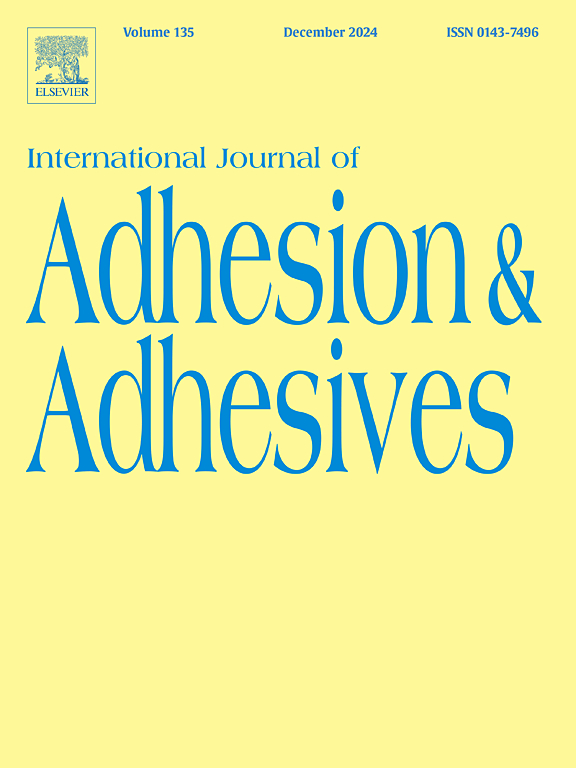Effect of adhesive material properties on phase-field analysis of T-peel adhesive joints using the Taguchi method
IF 3.2
3区 材料科学
Q2 ENGINEERING, CHEMICAL
International Journal of Adhesion and Adhesives
Pub Date : 2025-02-08
DOI:10.1016/j.ijadhadh.2025.103977
引用次数: 0
Abstract
This study investigates the effects of variations in elastic modulus (E), critical energy release rate (Gc), and length scale parameters (lc) on the failure behaviour of bimetallic T-peel joints using phase-field (PF) analysis. The PF method, recognised for its robustness, is particularly suitable for modelling interface problems and complex crack patterns. Since phase-field results are highly sensitive to material properties, this research aims to systematically evaluate the influence of these parameters using the Taguchi method. To achieve this, the PF model of T-peel joints was validated against experimental tests. The validated models were then employed in a Taguchi L9 design to quantify the effects of material parameters. A comprehensive analysis, including ANOVA and regression, was conducted to further examine these influences. Results indicate that the peak reaction force and the corresponding displacement are most significantly affected by the critical energy release rate, followed by the length scale parameter and elastic modulus. An increase in the critical energy release rate leads to a higher peak force and greater displacement at this force. Conversely, increasing the length scale parameter reduces both peak force and displacement. Interestingly, maintaining a constant ratio of Gc/lc does not alter the joint behaviour. Additionally, higher Young's modulus enhances joint stiffness, increasing peak force but reducing displacement at this force. This study provides crucial insights into optimising the mechanical performance of bimetallic T-peel joints and underscores the importance of material properties in PF-based analyses.
用田口法分析t型剥离胶粘剂接头相场时胶粘剂材料性能的影响
本研究利用相场分析(PF)研究了弹性模量(E)、临界能量释放率(Gc)和长度尺度参数(lc)的变化对双金属t型剥离节点破坏行为的影响。PF方法以其鲁棒性而闻名,特别适用于界面问题和复杂裂纹模式的建模。由于相场结果对材料性质高度敏感,本研究旨在采用田口方法系统地评估这些参数的影响。为此,对t型剥离节点的PF模型进行了实验验证。然后将验证模型应用于田口L9设计中,以量化材料参数的影响。综合分析,包括方差分析和回归,进行了进一步检查这些影响。结果表明,临界能量释放率对峰值反力和相应位移的影响最为显著,其次是长度尺度参数和弹性模量。临界能量释放率的增加导致更高的峰值力和更大的位移。反之,增加长度尺度参数会降低峰值力和位移。有趣的是,保持一定的Gc/lc比不会改变接头的行为。此外,较高的杨氏模量提高了关节刚度,增加了峰值力,但减少了该力下的位移。该研究为优化双金属t型剥离接头的力学性能提供了重要见解,并强调了基于pf的分析中材料性能的重要性。
本文章由计算机程序翻译,如有差异,请以英文原文为准。
求助全文
约1分钟内获得全文
求助全文
来源期刊

International Journal of Adhesion and Adhesives
工程技术-材料科学:综合
CiteScore
6.90
自引率
8.80%
发文量
200
审稿时长
8.3 months
期刊介绍:
The International Journal of Adhesion and Adhesives draws together the many aspects of the science and technology of adhesive materials, from fundamental research and development work to industrial applications. Subject areas covered include: interfacial interactions, surface chemistry, methods of testing, accumulation of test data on physical and mechanical properties, environmental effects, new adhesive materials, sealants, design of bonded joints, and manufacturing technology.
 求助内容:
求助内容: 应助结果提醒方式:
应助结果提醒方式:


